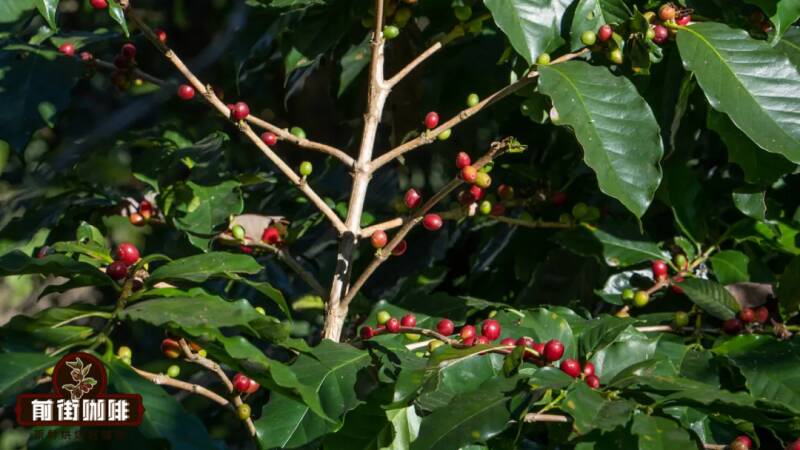What variety is Yunnan Arabica coffee? Where is the origin of Yunnan Arabica coffee? What is the relationship between Yunnan Xiaoli and Nestle?
Most of the coffee producing areas are famous, to a large extent, can not be separated from the local production of some coffee is very unique. For example, Blue Mountain Coffee in Jamaica, Rose Summer Coffee in Panama, Manning Coffee in Indonesia, and Yunnan small Grain Coffee in our country.
Although Yunnan Xiaoji is familiar, I believe many friends in Qianjie do not fully understand it. Therefore, today's Qianjie will come to share with you what on earth is: "Yunnan Xiao Grain".
What is Yunnan Xiaogu? Although there are more than 130 species of coffee, only 3 of them are of commercial value. They are Arabica, Robusta and Liberia. In order to identify them better, farmers call them small, medium and large seeds according to the size of the fruit.
Arabica is the smallest in it, so we can know that small grains of coffee refers to Arabica. So, Yunnan small grain naturally refers to Arabica coffee grown in Yunnan. But! As we all know, Arabica is a large species, it contains hundreds of different varieties, such as iron pickup, bourbon, Rosa and so on. Although Yunnan small grain generally refers to all Arabica coffee grown in Yunnan, in fact, the small grain varieties mainly planted in Yunnan in different periods are different. If you want to say what the difference is, it should be the difference between wizards of pure blood and half-blood wizards in the world of magic.
The planting history of Yunnan small grains of coffee in different periods can be traced back to the end of the Qing Dynasty, and it is recorded that coffee was introduced into Yunnan by two different groups of people. One group was introduced by the border people of the Jingpo nationality, and the other group was introduced by French missionaries most widely. In the 18th year of Guang Xu in the Qing Dynasty (1892), French missionary Tian Deneng introduced coffee from Vietnam and planted it in Zhu Kula Village, Binchuan County, Dali, and taught local residents a series of ways to handle, grind and brew coffee.
However, due to the local geographical location is very remote, inconvenient transportation, coupled with a relatively small planting area, so coffee did not quickly spread as widely as in other countries. It was not until the founding of New China that Yunnan Coffee really began its journey to fame. In 1952, experts from the Tropical Economic crops Research Institute of Yunnan Academy of Agricultural Sciences went to Jiafang Township, Dehong Prefecture to conduct an investigation. As a result, they found plants with red fruits that they had never seen before in their courtyards. So they purchased a large number of fresh fruits and brought them back to Lujiangba in Baoshan City for cultivation and research. It was finally identified as a "small grain of coffee" rich in South America.
Coinciding with the stage of economic development after the founding of the people's Republic of China, in order to supply coffee to the Soviet Union and the socialist brother countries of Eastern Europe, Yunnan soon began to popularize and promote the cultivation of coffee, and set up the first small-grain coffee planting base in China. Because the climatic environment of Yunnan is very superior, and with the assistance of foreign experts, the cultivation of coffee has been a great success! The flavor is unique, the yield is extremely high, and the planting area is as high as more than 50,000 mu, which makes Yunnan small grains enjoy a certain reputation in the international market at that time. At this time, word of mouth from Yunnan refers to the "old varieties" of pure Arabica pedigree such as Tippika and Bourbon planted in Yunnan.

If this "road" is unimpeded, then China may now be able to become a big coffee grower. Unfortunately, the good times did not last long, and in the 1960s and 1970s, the deterioration of Sino-Soviet relations brought the fledgling Chinese coffee to a halt. Many coffee plantations have stopped growing coffee and replaced it with other crops. Until, Brazil and other South American coffee-growing countries were eroded by leaf rust in the last century, production plummeted and coffee prices skyrocketed. In order to get rid of their dependence on these countries, some international coffee enterprises simply directly develop new coffee producing areas. Africa, Asia and other places are the key targets of the project. In 1988, during the wave of reform and opening up in China, Nestl é set up a joint venture in China and introduced Katim 7963 from the Portuguese Coffee Rust Research Center (CIFC). The purpose is to be able to acquire a batch of high-priced coffee bean raw materials for the production of instant products. For this reason, Nestl é made great efforts to promote the development of coffee agriculture in Yunnan, and established the Ministry of Coffee Agriculture in 1992, in order to better guide, study the cultivation and improvement of coffee in Yunnan.

But the main object of the study is still Katim, which is an Arabica species derived from a cross between the Timor variety and Kaddura. Timor is a hybrid of Arabica and Robusta, while Kaddura is a pure Arabica. So the hybrid Katim will have 3/4 Arabica consanguinity and will naturally be classified as Arabica species. The gene of Luodou makes Katim have extremely strong disease resistance and high production capacity, which is about three times that of the elder varieties such as iron pickup and bourbon. But it is precisely because of the existence of the Luodou gene that Katim's flavor is slightly inferior. "Wild, fishy, miscellaneous flavor" is Mr. Han Huaizong's description of the flavor of Katim before, you can associate it with yourself.
As said in front of the street, Nestl é's aim is to reduce the cost of raw materials for instant products. Therefore, although Katim's flavor is not good, it is more favored by people because of its high disease resistance and high yield. So, under the influence of Nestle, most farmers cut down the old varieties one after another, replaced them with Katim, and began large-scale cultivation! This wave of substitution reached the best part of the peak in the price of Brazilian coffee beans before 2010-2011, when Yunnan coffee beans reached an all-time high but quickly disappeared. Although the planting area of coffee in Yunnan is now as high as one million mu, 95% of it is planted by Katim. So you can know that although Yunnan Xiaogui generally refers to all Arabica planted in Yunnan, it now more refers to Katim, who is related to Luodou.
With the gradual growth of China's boutique coffee market, the improvement of coffee planting and processing in Yunnan has gradually erased the fishy and bitter taste of Yunnan coffee. However, in order for Yunnan coffee to form a world-recognized flavor of producing areas, Qianjie believes that it is still necessary to start from the root. In recent years, more and more old varieties with pure Arabica pedigree have been released in Yunnan, which fully shows that people have realized this view and gradually changed it. So, let's wait and see.
-END-
Important Notice :
前街咖啡 FrontStreet Coffee has moved to new addredd:
FrontStreet Coffee Address: 315,Donghua East Road,GuangZhou
Tel:020 38364473
- Prev

Which brand of hand-brewed coffee maker is better? Can a hand-brewed pot be heated directly? Hand flushing pot to boil water, hand flushing pot, hand flushing pot to inject water
Although it is not necessary to use a professional hand-brewed pot when making hand-brewed coffee, if you want to continuously reproduce delicious and delicious coffee, then a hand-sized filling pot is still indispensable. But when we open the shopping platform, we can find that the style of hand-brewed pots is not as simple as imagined. Wuhuaba
- Next

Too grabbing the horse! Customers placed orders and arrived at the store and found that Starbucks had closed down!
▲ Click to pay attention| Daily Boutique Coffee Culture Magazine Coffee Factory Yesterday, a netizen posted that he encountered a dramatic scene-Starbucks, which successfully placed an order, closed down. The customer said that he happened to see a discount advertisement for Starbucks Frappuccino on Meituan the afternoon before yesterday, and he was tempted to place an order and purchase the corresponding one.
Related
- Being chased out of the rain in front of Starbucks?! Store: Sheltering from rain under umbrellas poses a safety hazard
- The white moonlight has changed?! Lucky launches "Big Winter Pear American"
- Hand-brewed coffee three-stage method, high-sweet and universal brewing method to share! What does the high sweet water level of hand-brewed coffee mean?
- What is the difference between raw, refined and full espresso coffee? How to extract espresso and taste good?
- A complete list of coffee bean names and their meanings! What is Yejia Shefi coffee? Where is Mantelin coffee?
- What grade does Arida Manor Kaduai coffee beans belong to? What treatment is Arida ASD slow anaerobic sun exposure?
- The milk tea cup becomes smaller?! Overlord Tea Girl launches a new "Return to Yunnan" series
- Accused of selling counterfeit and high-priced coffee beans! Well-known boutique coffee brand "Oukelao" bowed and apologized!
- How to make espresso dumplings? Can I eat coffee and glutinous rice balls together?
- Save the unformed and stagnant powder cakes in one second! What is the problem with stagnant water in the powder bowl of the espresso machine?

